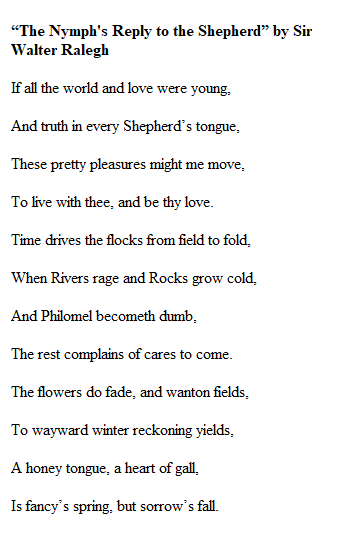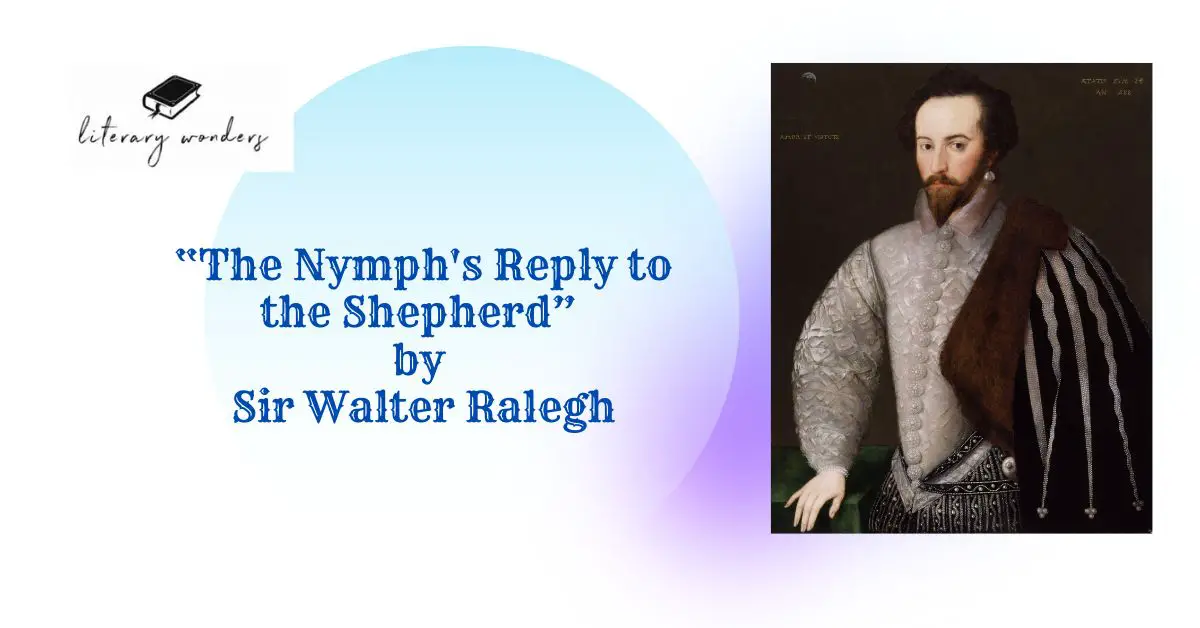
Summary of The Poem “The Nymph’s Reply to the Shepherd”
- Introduction to “The Nymph’s Reply to the Shepherd”: Sir Walter Ralegh composed the descriptive poem, “The Nymph’s Reply to the Shepherd” in the 16th century. This famous poem was written in response to Christopher Marlow’s “The Passionate Shepherd to His Love,” in which the shepherd begs his love to live in a rural idyll with him. In this poem, the great English writer and poet Sir Walter Ralegh discusses the harsh realities of existence. Due to its subject matter of the impermanence of time and the inevitability of death, the poem acquired immense popularity.
- Representation of Death in “The Nymph’s Reply to the Shepherd”: The shepherd speaks in the first person, and the nymph responds in the second person in this dialogue-style poetry. The nymph begins by explaining to the shepherd that because she is a nymph and must abide by the laws of nature, she cannot live in his pastoral paradise. She argues that even if they lived together in the country, they would ultimately get old and pass away, and the beauty of their youth would go. According to the nymph, the shepherd’s idea of a perfect life in the country is false, and the world is full of difficulties and perils. She advises the shepherd to give up attempting to maintain youth and beauty because they are ephemeral and unpreservable. The nymph instead counsels the shepherd to savor the present and accept death’s inevitable arrival. She still cares for the shepherd and wants him to be happy in life despite turning down his offer.
- Major Themes in “The Nymph’s Reply to the Shepherd”: The poem’s main themes include beauty, mortality, and fleeting time. This poem is a potent reminder of life’s transience and the importance of savoring the present. The nymph, who stands in for the natural world in the poem, answers the shepherd’s pleading with her to hold fast to her love for him. The nymph adds that she is unable to do this because time and the seasons have an impact on her. She reminds the shepherd that he must accept the ephemeral nature of their love and move on by comparing it to a fire that burns brightly but inevitably goes out. In the end, the poem serves as a reminder of everything’s fleeting nature, including love, and the necessity of letting go and accepting change.
Literary Elements Used in “The Nymph’s Reply to the Shepherd” by Sir Walter Ralegh
A simple composition is given clarity, depth, and richness through the application of poetic elements. To increase the poem’s intended impact, the poet has used a number of literary techniques.
- Assonance: When vowel sounds are repeated inside a single line, it is known as assonance. Examples include the vowel sound /e/ in “And truth in every Shepherd’s tongue” and the vowel sound /o/ in “When Rivers rage and Rocks grow cold.”
- Consonance: The repetition of consonant sounds inside a single line is referred to as consonance. Examples include the sound of /t/ in “These pretty pleasures might me move” and the sound of /r/ in “When Rivers rage and Rocks grow cold.”
- Caesura: A caesura is a pause or break in the middle of a verse line. These pauses may occur towards the start, middle, or finish of a line. In lines like “To live with thee, and be thy love,” the poet makes use of this method.
- Diction: The poem displays descriptive diction having rhetoric devices, symbolism and impressive images
- Enjambment: Enjambment is described as a poem form in which a concept continues onto the next line rather than ending at the line break. For instance;
“Then these delights my mind might move
To live with thee, and be thy love.”
- Imagery: Using imagery, authors can influence how readers experience things using all five senses. With phrases like “But could youth last, and love still breed,” “Thy gowns, thy shoes, thy beds of Roses,” and “The flowers do fade, and wanton fields,” create a perfect picture in the reader’s mind.
- Metaphor: This figure of speech compares two fundamentally unrelated things. In order to represent the harsh truths of life, the poet employed the ephemeral nature of time as an extended metaphor in the poem.
- Quatrain: A quatrain is a four-lined stanza borrowed from Persian poetry. Here, each stanza is a quatrain, as the first one and the second one.
- Rhyme Scheme: The poem follows the AABB CCDD rhyme Scheme until the last line.
- Symbolism: Symbolism is the use of symbols to represent concepts and traits by giving them deeper, more symbolic meanings than their literal interpretations. The poem employs metaphors for things like life, death, time, beauty, and speech.
- Tone: The tone of the poem is one of skepticism and realism.
To sum up, this poem is a flawless read thanks to the deft use of these elements.
FAQS about “The Nymph’s Reply to the Shepherd” by Sir Walter Ralegh
1. What is the background of “The Nymph’s Reply to the Shepherd”?
This poem was written as a response to Christopher Marlowe’s poem, “The Passionate Shepherd to His Love.” In Marlowe’s poem, a shepherd tries to woo a nymph with promises of an idyllic life in nature.
2. Who was Sir Walter Raleigh?
Sir Walter Raleigh was a famed English writer, explorer, and soldier in the late 16th century. He is known for his role in exploring and colonizing the New World. Also, he is adored globally for his astounding literary marvels, including this poem.
3. What is the main theme of “The Nymph’s Reply to the Shepherd”?
The main theme of the poem is the fleeting nature of beauty, love, and material pleasures. The nymph’s response to the shepherd’s promises conveys a more realistic and skeptical view of love and nature.
4. How does the nymph respond to the shepherd’s advances in the poem?
The nymph responds to the shepherd’s advances by expressing doubt and scepticism. She fears that the shepherd’s promises of eternal love and a life of bliss in nature are unrealistic and that they will not last.
5. How does this poem contribute to the pastoral tradition in literature?
“The Nymph’s Reply to the Shepherd” is an important example of pastoral literature, a genre that idealizes rural life and nature. However, it also subverts the conventional pastoral themes by presenting a more realistic view of love and nature.
Suggested Readings

